Related Research Articles
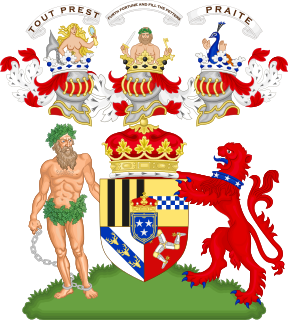
Duke of Atholl, named for Atholl in Scotland, is a title in the Peerage of Scotland held by the head of Clan Murray. It was created by Queen Anne in 1703 for John Murray, 2nd Marquess of Atholl, with a special remainder to the heir male of his father, the 1st Marquess.

The Dukedom of Albemarle has been created twice in the Peerage of England, each time ending in extinction. Additionally, the title was created a third time by James II in exile and a fourth time by his son the Old Pretender, in the Jacobite Peerage. The name Albemarle is derived from the Latinised form of the French county of Aumale in Normandy, other forms being Aubemarle and Aumerle. It arose in connection with the ancient Norman Counts of Aumale of Aumale in Normandy. See also Earl of Albemarle.

Earl of the Island of Jersey, usually shortened to Earl of Jersey, is a title in the Peerage of England held by a branch of the Villiers family, which since 1819 has been the Child-Villiers family.

Earl of Malmesbury is a title in the Peerage of Great Britain. It was created in 1800 for the diplomat James Harris, 1st Baron Malmesbury. The son of the grammarian and politician James Harris, he served as Ambassador to Spain, Prussia, Russia and France and also represented Christchurch in the House of Commons. Harris had been created Baron Malmesbury, of Malmesbury in the County of Wiltshire, in 1788. He was made Viscount FitzHarris, of Hurn Court in the County of Southampton, at the same time as he was given the earldom. The earldom and viscountcy were the last creations in the peerage of Great Britain, future titles being made in the peerage of the United Kingdom which took effect three days later.

Earl of Romney is a title that has been created twice.

Earl of Strafford is a title that has been created three times in English and British history.
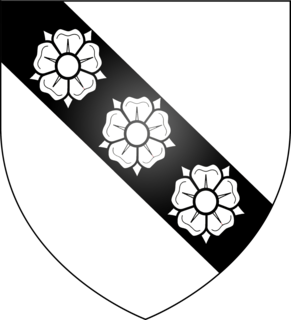
Baron Hunsdon is a title that has been created three times.
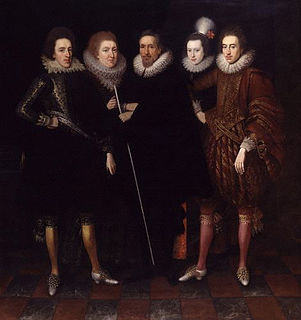
Earl of Monmouth was a title that was created twice in the Peerage of England. The title was first created for English courtier Robert Carey, 1st Baron Carey in 1626. He had already been created Baron Carey, of Leppington, in 1622, also in the Peerage of England. The titles became extinct upon the death of his son, the second Earl, who died without surviving male issue in 1661. The second creation, in 1689, was for the great-grandson of the first Earl of the first creation, Charles Mordaunt, 2nd Viscount Mordaunt. In 1697 he succeeded his uncle as Earl of Peterborough. See the latter title for more information.

Viscount Clifden, of Gowran in the County of Kilkenny, Ireland, was a title in the Peerage of Ireland. It was created on 12 January 1781 for James Agar, 1st Baron Clifden. He had already been created Baron Clifden, of Gowran in the County of Kilkenny, in 1776, also in the Peerage of Ireland. The Viscounts also held the titles of Baron Mendip in the Peerage of Great Britain from 1802 to 1974 and Baron Dover from 1836 to 1899, when this title became extinct, and Baron Robartes from 1899 to 1974, when this title became extinct, the two latter titles which were in the Peerage of the United Kingdom. The interrelated histories of the peerages follows below.
Viscount Rochford is a title that has been created twice in the Peerage of England.

Earl of Norwich was a title that was created four times in British history, three times in the Peerage of England and once in the Peerage of Great Britain. The first creation came in the Peerage of England in 1626 in favour of the courtier and politician Edward Denny, 1st Baron Denny. He had already been created Baron Denny, of Waltham in the County of Essex, in 1604, also in the Peerage of England. Lord Norwich was the grandson of Sir Anthony Denny, confidant of Henry VIII, and the nephew of Sir Edward Denny. He had no sons and the titles became extinct on his death in 1630.

Earl of Peterborough was a title in the Peerage of England. It was created in 1628 for John Mordaunt, 5th Baron Mordaunt. He was succeeded by his eldest son, Henry, the second Earl. He was a soldier and courtier. Lord Peterborough had two daughters but no sons. He was succeeded in the barony of Mordaunt by his daughter, Mary, 7th Baroness. The earldom was passed on to his nephew, Charles Mordaunt, 1st Earl of Monmouth, who became the third Earl. He was a prominent soldier and politician. In 1705 he also succeeded his cousin Mary in the barony of Mordaunt. His eldest son John Mordaunt, Viscount Mordaunt, predeceased him, and Lord Peterborough was consequently succeeded by his grandson, Charles, the fourth Earl. The barony of Mordaunt, the viscountcy of Mordaunt and the earldoms of Peterborough and Monmouth, became extinct on the death of the latter's son, the fifth Earl, in 1814. The barony of Mordaunt was passed on to his half-sister, Lady Mary Anastasia Grace Mordaunt.

Henry Jermyn, 3rd Baron Jermyn and 1st Baron Dover, 1st Jacobite Earl of Dover PC was an English peer and supporter of James II.
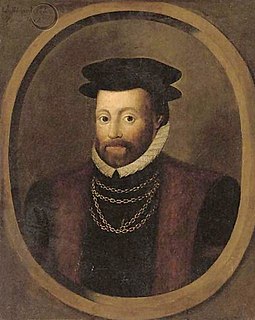
Baron North, of Kirtling Tower in the County of Cambridge, is an abeyant title in the Peerage of England. Its most famous holder was Frederick North, 2nd Earl of Guilford, 8th Baron North, who served as Prime Minister of Great Britain from 1770 to 1782, a period which included most of the American Revolutionary War.
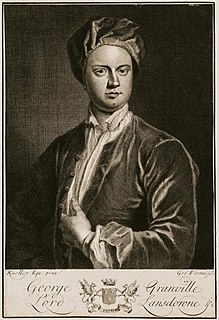
George Granville, 1st Baron Lansdowne PC, of Stowe, Cornwall, was an English Tory politician who sat in the English and British House of Commons from 1702 until 1712, when he was raised to the peerage as Baron Lansdown and sat in the House of Lords. He was Secretary at War during the Harley administration from 1710 to 1712. He was also a noted poet and made a name for himself with verses composed on the visit of Mary of Modena, then Duchess of York, while he was at Cambridge in 1677. He was also a playwright, following in the style of John Dryden.

Lieutenant-General Charles Butler, 1st Earl of Arran, de jure3rd Duke of Ormonde (1671–1758) was an Anglo-Irish peer. His uncle Richard was the 1st Earl of Arran of the first creation. The titles were re-created for Charles in 1693. His elder brother, the 2nd Duke of Ormonde, was attainted during the Jacobite rising of 1715, but in 1721 Arran was allowed to buy the estate back. At the death of the 2nd Duke, he succeeded as de jure 3rd Duke of Ormonde in the Peerage of Ireland but did not claim the title.
Baron Dover is a title that has been created three times, once in the Peerage of England, once in the Peerage of Great Britain and once in the Peerage of the United Kingdom. All three creations are now extinct.
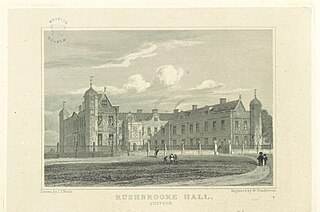
Baron Jermyn, of St Edmundsbury, was a title in the Peerage of England.
Henry Carey, 1st Earl of Dover of Hunsdon, Hertfordshire was an English peer and Member of Parliament.
John Carey, 2nd Earl of Dover, styled Viscount Rochford from 1628 to 1666, was an English peer. He was the eldest son of Henry Carey, 1st Earl of Dover, and Judith, daughter of Sir Thomas Pelham, 1st Baronet. He was educated at St John's College, Cambridge.
References
- ↑ One or more of the preceding sentences incorporates text from a publication now in the public domain : Chisholm, Hugh, ed. (1911). "Dover, Henry Jermyn, Earl of". Encyclopædia Britannica . Vol. 8 (11th ed.). Cambridge University Press. p. 453. This cites:
- Samuel Pepys' Diary, edited by H. B. Wheatley, 9 vols. (London, 1893);
- Anthony Hamilton, Memoirs of Grammont (Bohn edition, London, 1846);
- James Stanier Clarke, Life of James II, 2 vols. (London, 1816);
- Narcissus Luttrell, Brief Relation of State Affairs 1678-1714, 6 vols. (Oxford, 1857).